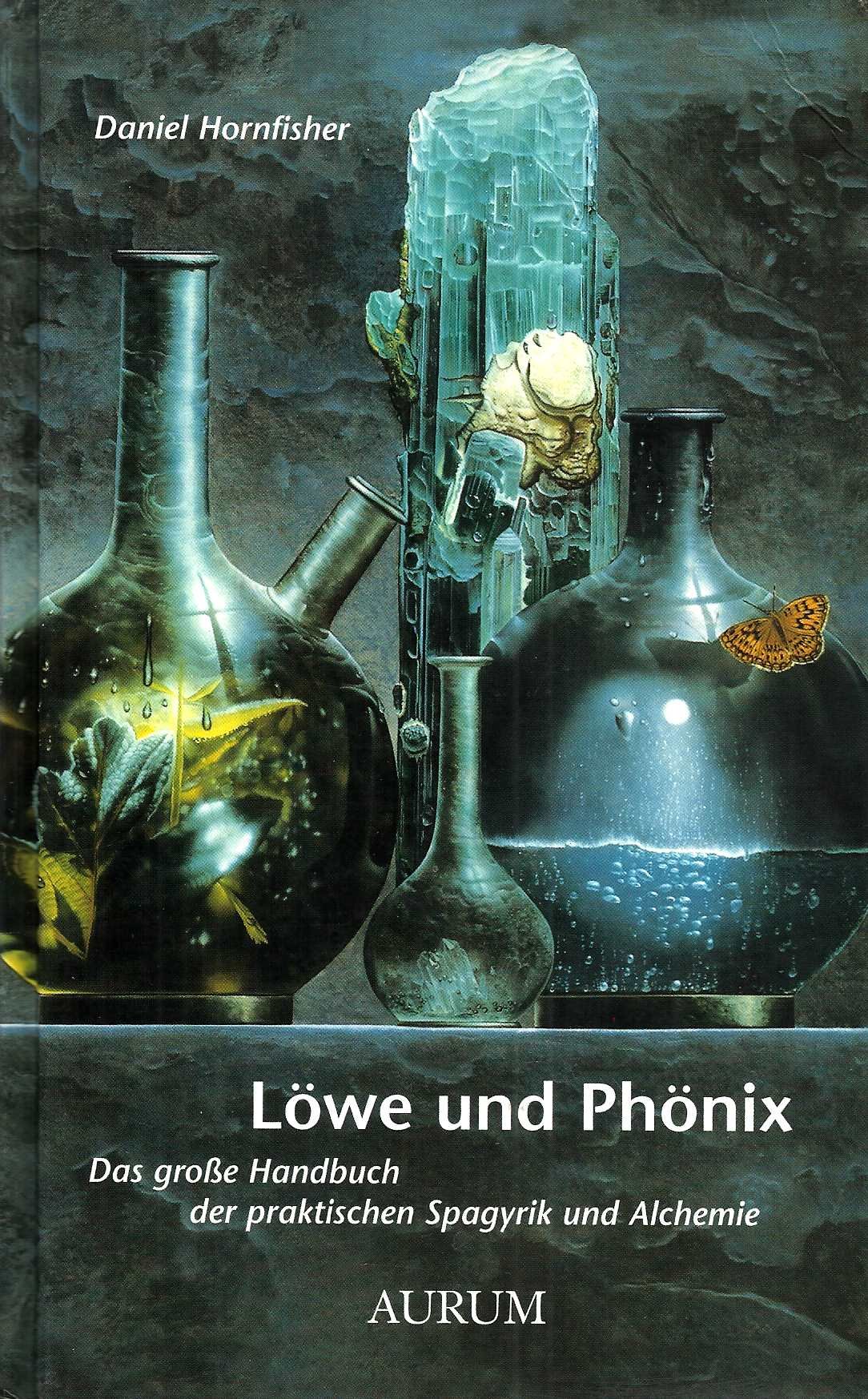
Daniel Hornfisher’s book “Löwe und Phönix” (engliAH: Lion and Phoenix) appeared in 1998 in the German publishing house “Aurum” , was soon sold out and has become quickly a highly sought modern classic on practical alchemy. Maybe it is the single occult book to ever receive a »Goethe Price« in Weimar (1999)
An absolutely unique treasure in any collection on alchemy is »Löwe und Phönix« (»Lion and Phoenix«) by Daniel Hornfisher, which appeared in Germany during the late 1990ies.
Soon after, this practical guide to alchemy was already sold out. Used copies are now being sold on the second hand market for prices up to 20 times higher than the initial retail price. In 1999 it received even – as the single esoteric book – the »Goethe« price in Weimar.
Indeed, the book is unique – not only in it’s (seemingly) simplicity: After a short series of definitions and a mini history of Alchemy Daniel Hornfisher explains without further ado in small steps the basics of any alchemical operation, the processes, tools and materials involved, and the symbolism behind starting with plant spagyrics.
Already after the first quarter of the book the reader can start his own alchemical / spagyric operations at home, starting with simple ingredients and utensils – but nevertheless based on old classic »recipes«. The remainder of the book deepens the knowledge by introducing further alchemical notions, explaining ancient or classic alchemical texts and guiding the reader into translating them into modern day language and breaking them down into practical steps. Often discussed are Hollandus, Basil Valentine or George Ripley. This is fast to read, but a bit harder to comprehend without doing actually the work and gaining experience. An introduction to »Inner Alchemy« helps to blend the outer work with the corresponding inner work. Overall, the whole program can take some years at least to turn into practice. There are many reprints of old Alchemical texts around nowadays such a practical guide on how to approach them is still rare. All in all, the book is unique.
Mr. Hornfisher runs his own edition (The »Edition Hornfisher«, available over the Schulten publishing house at fulcanelli.de and part of the S) in Germany, with a selection of alchemical facsimiles, books on herbs, the occult and local lore. So it is our pleasure to have Mr Hornfisher today as a guest on theoldcraft.com
AH: Mr, Hornfisher, let’s start with a simple question, which may be not so simple at all nowadays: what is alchemy?
DH: Alchemy is the art of eliciting a soul from matter.
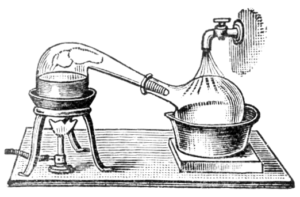
Distillation is one of the basic procedures in alchemy. The picture shows a retort, which is based on the alembic, which we often find in ancient alchemical texts. The alembic is a distillation deceive consisting of two glass or ceramic vessels connected by a tube: the distillation flask or »cucurbit« contains the liquid to be distilled, a »head« or helmet then is set on the receiving vessel, with a long tube leading into the mouth of the distillation flask. Under heat vapor rises, leads the mouth into the helmet of the alembic where it cools down into the receiving flask. The retort, has the helmet with the tube already »hardwired« to the receiving flask. Together, the alembic and retort form a microcosmos in which liquids can rise »to heaven« and then return »to earth«, but which allows for separation of ingredients.
AH: So, it is still about physical work in the lab with very physical substances. So what is your take on the now popular notion which reduces alchemy to a mere psychological process, or metaphor for spiritual development?
DH: In alchemy, too, there are always fads, some of which are due to the prevailing Zeitgeist. The heyday of a purely psychologically or spiritually oriented interpretation of the Hermetic Art was from the 1950ies to the 1980ies, when depth-psychology according to C. G. Jung and Eastern Philosophy became accessible to a broader mass. Today, it seems to be turning again more in favor of laboratory practice, I feel. Even a fervent advocate of the “depth-psychological theory” such as Israel Regardie quickly came to the conclusion, that the sole fixation on it is not very helpful. Alchemy can be practiced purely spiritually or purely in the laboratory. In my opinion, however, you get the most out of it, if you skillfully combine both.
We could observe another hype a few years ago: In the “Book of Aquarius” the author propagated, that the Philosopher’s Stone must be created from urine. This is of course complete nonsense (which does not speak against the fact, that valuable products can be made from urine and other animal products by spagyric means). But I do find the idea quite charming, that there was a time in human history when there was a flask of rotting urine in many kitchens around the world, the contents of which were supposed to make sure, that at some point the house credit would be paid off.
AH: So alchemy is still about – inter alia – making gold, in the very physical sense?
DH: Absolutely! Even though physics and chemistry insist that this is impossible, partly because it violates the Second Law of Thermodynamics.
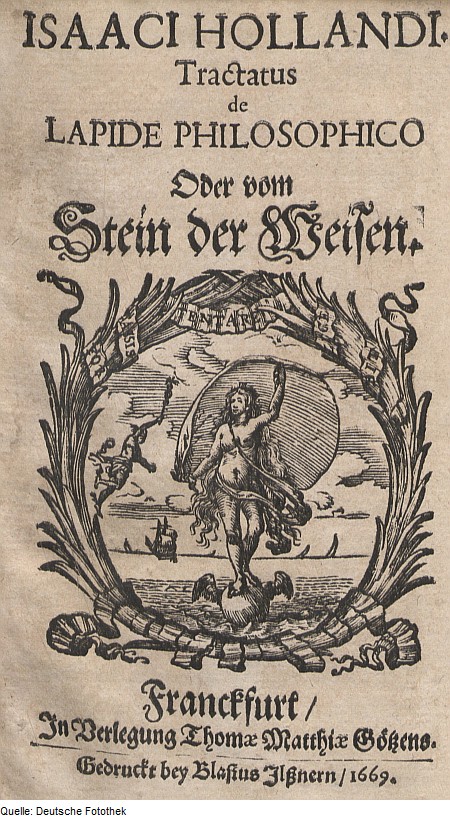
Cover page of Isaac Hollandus’ treatise on the philosopher’s stone. Woodcut on paper, Frankfurt, 1669.
The philosopher’s stone, Latin: »Lapis philosophorum« or German: »Stein der Weisen«, is the Opus magnum of Alchemy and known under a large variety of names: »Red Lion«, »Great Magisterium«, »Red Tincture« but also »Aurum Potabile« or the »Elixir of Life« if dissolved in liquid for inner application. Once achieved, it shall be able to transmute base metals such as lead into noble ones such as gold or silver. Moreover, as panacea it heals any kind of disease and can rejuvenate the body and prolong life. The magnum opus is sometimes divided in 4, 7 or 12 steps.
AH: There also seems to be some evidence that there is a principle possibility to transform one chemical element into another. Particle accelerators have been reported to transmute bismuth, a close to lead element into gold – even though at a cost exceeding by far the value obtained. So what is the final goal of alchemy and its quest for the philosopher’s stone?
DH: Yes, there are numerous indications that transmutations can also take place at low energy levels. Perhaps the Second Law of Thermodynamics need not necessarily be questioned by a transmutation …
I personally do not think there should be an ultimate goal in alchemy. What should you do when you have achieved it? Retire? Commit suicide? The Great Work is a process of continuous unleashing. There is no end to the liberation from the bonds that all rigid structures impose on us by their very existence, whether material or otherwise, or to the refusal of accepting the fundamental powerlessness of “things just are the way they are”. As Aleister Crowley wrote: “The whole universe is but an illusion. – But one that’s hard as hell to get rid of!“
If we focus too much on one goal, we quickly lose sight of all the wonders that we constantly encounter and that we can continue to pursue. Even the Philosopher’s Stone is not regarded by many Hermetics as the final destination of the Great Work, but merely as a “parergon” (πάρεργον), an accessory that is a proof of great skill and that has great advantages, but in which the work is by no means exhausted.
I rather compare the Great Work with the mythological topos of the Wild Hunt. This hunt is an enigma and seemingly pointless, and it knows no direction and no destination, and whoever it encounters is not the same anymore.
AH: How did you yourself get started with Alchemy?
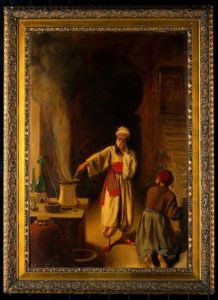
Rhazes oder Rasis, the latin form for ar-Rāz (short for Abū Bakr Muḥammad ibn Zakariyyā ar-Rāzī) was a Persian alchemist, physician and polymath around the 9th century. Rhazes was one of the early Arabian alchemists, which should have a huge impact on the revival of Alchemy in the West in medieval times and thereafter. The painting shows Razhes as an alchemist in his Laboratory in Bagdad, by Earnest Board. Image CC BY 4.0 via Welcome Gallery
DH: For as long as I can remember, I have always been interested in all occult topics, herbal lore and natural healing, and alchemy has always played a special role. However, the beginning of my practical experience started a bit bumpy: When I was at primary school, I secretly bought (because I was not allowed to read this kind of stuff) an annual astrological calendar-book, which also covered many other esoteric topics. To my great joy I discovered a slightly strange text in it, written by the Arabic alchemist Rhazes (Abū Bakr Muḥammad bin Zakaryā-ye Rāzī): “The recipe to make gold.” − “Hey, that sounds cool”, I thought to myself and went to the nearest pharmacy, where I asked for “lime of gold”, “red mercury”, “whitened sulphur”, and “water of sal ammoniac”. When the pharmacist said, she didn’t know all this stuff and asked me what the hell I wanted to do with it, I replied something like: “I want to make Red Nuqra out of it, of which one Mithqāl turns 500 Mithqāl of any metal into fine gold.”, as I had read in the recipe. I don’t know if the good woman thought I was kidding her or if she believed me to be a little nuts, in any case I had to make my way home without the hoped-for treasures.
About the same time I found in Hans Biedermann’s „Handlexikon der magischen Künste“ (“Concise Dictionary of the Magical Arts”) a description from the Hollandus’-writings how to make the Philosopher’s Stone from “Vitriol” and “Vinegar”. Since I was the proud owner of a chemistry kit, I tried to put the recipe into practice with these alleged substances, of course without success.
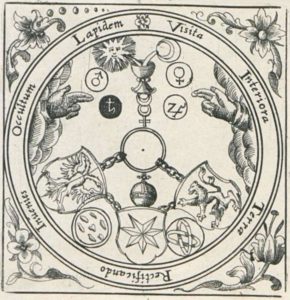
Vitriol is the trivial name for compounds containing sulfates, such as the blue »copper flower« chalcanthite or other divalent sulfates as from iron (green – ferrous sulfate). However, VITRIOL also became an alchemical Motto. The picture above shows an icon from the »Viridarium Chymicum« (Chymisches Lustgärtlein) by Stolz von Stolzenberg, 1624. VITRIOL is here a short for »Visita interiora terrae, rectificando invenies occultum lapidem«: »Visit the interior of the earth and rectifying (purifying) you will find the hidden stone.« We find this motto first in Basil Valentine’s »L’Azoth des Philosophes«, where it appears in its complete form as »Visita interiora terrae, rectificando invenies occultum lapidem, veram medicinam« (the difference being here the addendum »veram medicinam« – the »true remedy/cure«). Later, we find the motto in Rosicrucianism and the »Chamber of Reflection« in Freemasonry.
After this somewhat frustrating start, I shifted – still during my primary school years – to more tangible things like the production of gunpowder and other explosives. When I spent the Easter holidays with my great-aunt for example, I visited a boy of the same age from my distant relatives for a few days. When we were bored, we thought it would be quite funny to send my grandaunt a package, that would explode, when she opened it. We had absolutely nothing bad in mind, but we believed it was a harmless prank that would go non-hazardous like in a comic. So we constructed an igniter by attaching a match, which could be lit on a rough surface, to the bottom of a box with a thread. We stuck the head of the match between a clothes-clamp, to the inside of which we had glued some emery paper, and we attached this clamp to the lid of that box, which we filled generously with homemade gunpowder. Finally we put some nice wrapping paper around the packet. If my great-aunt were to open this present, the match would ignite on the rough surface of the emery paper, then fall on the gunpowder, thus creating a lot of good humour and merry laughter, we thought. Originally we had planned to send her this package by mail. But we decided differently, so that we could watch my grandaunt opening her surprise present as a life event. When the glorious day finally arrived, and my poor great-aunt’s car showed up, we ran excitedly with the package towards the front door. But − luckily for my grandaunt and all of us − it slipped out of our hands in the living room and fell to the floor. Just as we were about to pick it up again, a several metres-long darting flame and thick, sulphurous vapours shot out of it, ruining the brand new living room carpet completely and almost setting fire to the rest of the house. This was the last time, I was invited to this boy’s family … I sometimes wonder, what would have happened, if we had sent the package by post. Those days were the heyday of the Red Army Faction (RAF) in Germany. A burnt-out mail truck or a devastated post-office would certainly have been blamed on them.
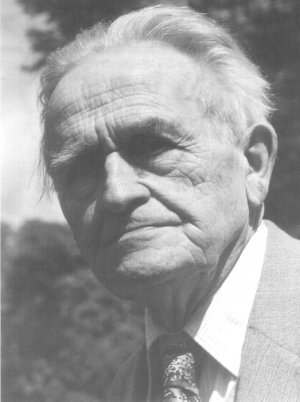
Alexander Freiherr von Bernus (1880 –1965) was a German alchemist, spagyric practitioner, writer and polymath with wide-ranging interests: He studied in Munich Philology, Philosophy, Chemistry and Medicine, published poetry (20 poetry collections and an estimated 1,000 poems, but also prose, drama, novels, theatre plays and mystery plays – about 450 works in total to which add several translations from English such as William Blake and Dante Gabriel Rosetti) and was well received in Germanies literary elite circles with close contacts to writers such as Stefan Zweig, Frank Wedekind, Rainer Maria Rilke, Thomas Mann, Hermann Hesse and many others. Rudolf Steiner, Alfred Kubin and Else Lasker-Schüler wrote in his philosophical-anthroposophical magazine “Das Reich”. As alchemist he stood in the tradition of Paracelsus and developed in his laboratory SOLUNA over 30 spagyric remedies. The same-named company SOLUNA commercializes these until today. The gross of his legacy is preserved today at the German Baden State Library
After this „alchemical awkward age“ a more serious study of the Hermetic Art began, starting with Alexander von Bernus’: “Alchymie und Heilkunst”, and also a more serious practice, supported for a while by a personal teacher who had worked closely with von Bernus and other known and unknown adepts.
I came across the subject of detonations again a few years ago, when a retort exploded directly in my hand during the production of the “Secret Fire”, with a violent development of huge flames and nasty, caustic fumes. This event could have killed me, or at least I should have been mutilated, burned, poisoned, cauterized, blinded and disfigured. But miraculously, absolutely nothing happened to me. Not a single drop of blood was spilled, not one hair was singed. Nevertheless, this event showed me that in all our works, even the seemingly familiar or even harmless ones, we must never become careless. At the same time, the effect of the “Secret Fire” has become clearer to me: In the alchemical work, its explosive, hot power is not directed outwards in a flash, but unfolds inwards in a long, slow, organic process, thus causing a restructuring of seemingly unchangeable structures. − This is why it is also called “the fire against nature”! I know, I’m getting close to possibly questioning the universal validity of the Second Law of Thermodynamics, but that is a burden I have to live with. In one of his posthumous works, Austin Osman Spare writes that we always imagine infinity as “infinitely large”, but we never think of it also as “infinitely small”, which nevertheless exists in just the same manner. Taken in this way, this fact is one of the keys to the art of Alchemy.
AH: Do you work alone?
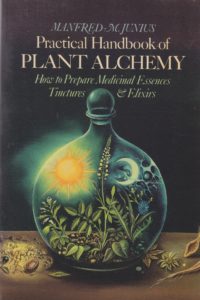
Manfred Junius, author of the modern classic »Handbook of Plant Alchemy – How to Prepare Medicinal Essences, Tinctures and Elixirs« studied pharmacology in Germany but left early for India where he pursued his passion music and even advanced to become a professor for Indian Music. He entered the world of Alchemy first under the guidance of the Italian Augusto Pancaldi. Later, back in India, Junius studied Ayurveda, became even Doctor and lecturer. Junius spoke reportedly 14 languages, and moved in 1979 to Australia, where he started »Australerba Laboratories«, a company focused on spagyric and ayurvedic remedies. Manfred Junius died in Australia in 2004 at the age of 75.
DH: Yes. But there are several small groups scattered around the world, who receive instructions from me. Besides my already mentioned teacher of my youth, I worked closely with my good friend Achim Stockhardt for several years, until his sudden and much too early death. He was an intimate confidant of Manfred Junius and Isa von Bernus, the widow of Alexander von Bernus, and for some years he was the laboratory manager of von Bernus’ spagyric company “Soluna”.
AH: And are there alchemical operations which require more than one participant?
DH: Of course it makes a lot of things easier, when you work together or even in a group, not to mention the fun factor. But operations, for which this would be absolutely necessary, are not known to me.
AH: Your book “Löwe und Phoenix” was very soon sold out. Used copies are sold for prices up to twenty times the initial price. This seems like a huge success. How come that there has been no new edition so far?
DH: Shortly after the „Aurum-Verlag“, which had published “Löwe und Phönix”, was awarded the “Goethe-Verlagspreis” for my book on Goethe’s 250th birthday in Weimar, it was taken over by another publishing house. This changed the general programme orientation which shifted more towards Advaita, so there was no space for a book like this.
But later I became quite comfortable with this situation. There are so many publishers who try to create a scarce item artificially, a kind of “real-life Necronomicon” by extremely limited editions of their books, special features, additional supplements etc. But if a book becomes a kind of myth and a legendary collector’s item on its own, then it is the natural development that it wants to take place, and this should not be stopped.
It is still quite possible to get a copy of my book from an antiquarian or that it can be viewed in a library. You just need a little patience, or you might have to save for a while, both things that are not very popular.
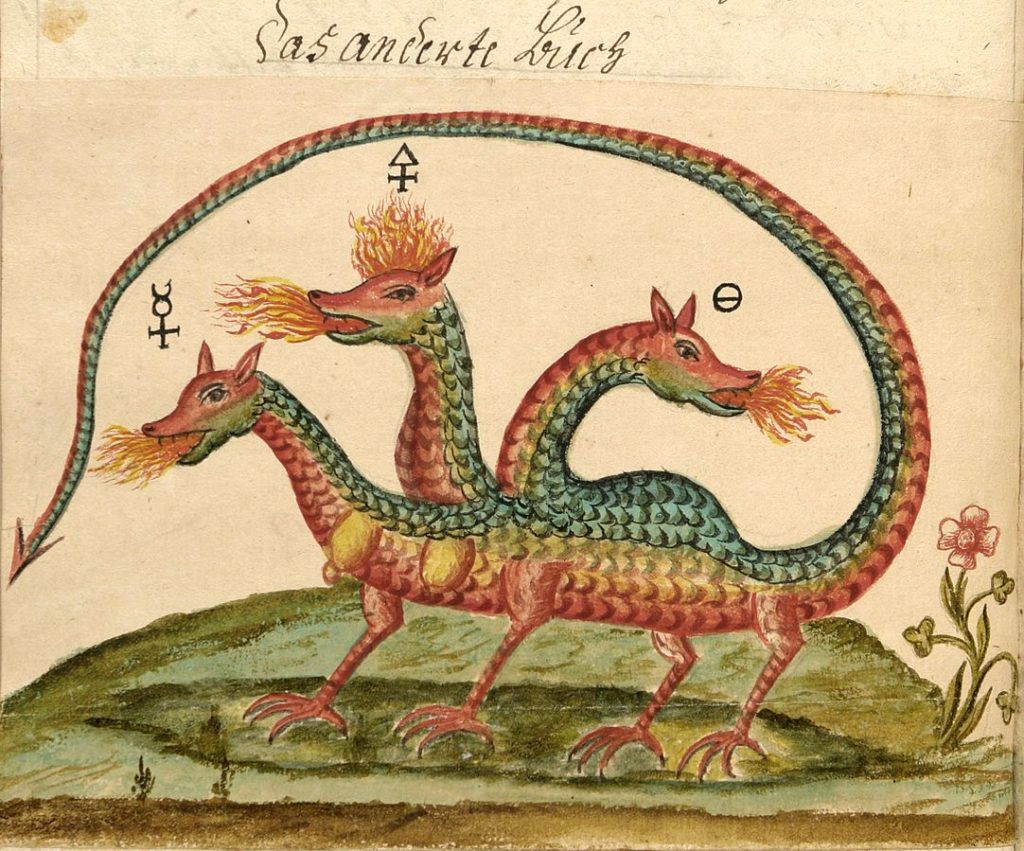
The image shows a three-headed dragon – the dragon or snake is an often-used symbol for the »prima materia«. Here the three heads symbolize the three basic alchemical principles Sal(t) (the physical plane), Sulfur (astral – soul) and Mercury (mental – mind) – they are an inherent part of the same prima materia. Like all hermetic traditions, alchemy is based on the platonic assumption that the pure nature of things and beings contaminates in the real world with impurities or at least non-essential-features – named »feces«. Respectively it is assumed that substances (and beings) ripe over time to perfection. Thus, the alchemist does not seek to isolate singular »active substances« – as chemistry typically does – but aims to set free the true nature of the material he is working with, in its final state as it was meant to be. This for, he will separate from the base material he is working with the three aforementioned »philosophical principles«: sal, sulfur and mercury and clean them from »feces«. Later he will reunite the now cleaned or sublimed three principles extracted of the base material, usually also aided by procedures, which assure better adaptability to the human body. Confusion is often caused as, salt, mercury and sulfur sometimes refer to the alchemical principles, other times to the physical substances, and then again it may in the case of mercury it may also refer to the planet… The seven planets and the four elements are likewise important in alchemy and part of the symbolism Sometimes their corresponding metals are named instead of the planet and vice versa, adding much to the confusion. Image: Clavis Artis, a 17th century manuscript on alchemy.
When I held my first “real” alchemical book in my hands, a reprint, at about ten years of age, I had saved almost a whole year for it. The moment when I finally opened it, however, was a bitter shock for me, because the text was set in Gothic script, which was illegible for me. But instead of giving up, I started to try to decipher the text. After a while, I managed to identify single words, then single sentences, at some point whole paragraphs, and soon reading was as natural to me as any other writing. But when the text was readable for me, the next difficulty arose: The Baroque or New High German language of past centuries is anything but easy to digest on first contact. Many people can’t handle it at all. But here too, I just kept on reading, until at some point I even learned to appreciate this old diction very much.
In the past I also often went to other cities to study old alchemical manuscripts and books in libraries that I could not get through interlibrary loan. Additionally I had microfilms made for me from those writings, that were particularly important to me, which was very expensive and was only topped by the cost of processing them. Being a really poor student at that time, this almost ruined me. Some texts I even copied by hand.
Today we are used to receiving information and knowledge at the push of a button. This can sometimes be very practical and shorten things. However, relying solely on such a form of knowledge transfer is fatal. One aspect of this negative tendency is that it makes us unlearn to actually value and internalize knowledge. It becomes a pure, exchangeable consumer good. It is dead. Other cultures are also confronted with this problem:
In the third volume of his fascinating trilogy on “The Thai Occult”, Peter Jenx writes for example about the Thai way of passing on esoteric knowledge: „Technology is another problem, as everything gets passed on quickly through copying photographs and written descriptions without any associated understanding or experience. In the past, a student had to sit down and write everything by hand, and then test the magic, so the magic itself came from the experience of creating magic. The old way of teaching was to give their students a test to see how devoted they were, how smart they were and how eager.“ (“The Thai Occult, Appendix”, Timeless 2020, p. 67)
I’m really not someone who likes to complicate things. Where simplifications are useful and necessary, one should definitely prefer them. Sometimes, however, it is the winding path that leads to the goal, because the serious effort that you invest in it will pay off many times over at some point.
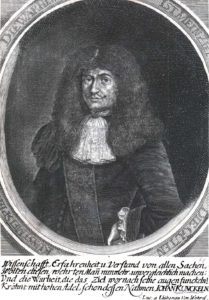
Kunckel von Löwenstern, sometimes Kunkel, born Johannes Kunckel was a German Alchemist of the 17th century. Renowned until today as successful glassmaker – the red glass was one of his inventions – and knighted by king Charles XI of Sweden left several writings on early chemistry, glass manufaction and alchemy. The Laboratorium chymicum is considered one of his main works.
I still remember exactly that holy moment when I opened my first really old alchemy book, which I had bought from an antiquarian bookshop, an edition of Kunckel von Löwenstern‘s “Laboratorium Chymicum” of 1716. The fascination of reading in a haptically, tangible piece of the past and not in a facsimile or on a screen, is difficult to put into words. Since then, I have incorporated hundreds of such originals, printed as well as handwritten, into my collection, and this fascination has been the same for each one of them, and reading a book in this state of enchantment can open doors of understanding that would otherwise remain closed. One might dismiss these words as the personal passion of a bibliophile or even a bibliomaniac, but this approach is one of the ways to connect us directly with our tradition.
There are various publishers in the occult field such as Theion Publishing, Ouroboros Press, Xoanoan, Three Hands Press, Troy Books, Scarlet Imprint, The Society of Esoteric Endeavour, Ixaxaar, Fulgur etc. who try to evoke exactly that with their “talismanic editions”. David Beth, one of the owners of “Theion” writes about this on his homepage: „Theion Publishing is firmly convinced that a book may potentially become alive. We consider bookmaking an alchemical process aiming at the creation of a perfect vehicle for the transformative nature of the wisdom it embeds. Through the exact fusion of outer and inner, not only a book of supreme beauty comes into being, but also, and more importantly, a fetich in the true magical sense. The physical manifestation of an auric book gives birth to an entity through which a reader may enter ever deeper into the Gnosis.“
Here, too, a look at Asia shows a similar understanding of the possible role of a book: „Some Wicha [knowledge gained through study or practice] books are considered to be alive and need to be cared for properly, especially when an old Ajarn [a lay practitioner of the Occult arts] dies, as they can go wild.“ (“The Thai Occult”, Appendix, Timeless 2020, p. 13)
A while ago I bought a Pustaha manuscript from the 19th century at an auction. These are oracle books written in ritual language by the magic priests of the Batak, a people in Sumatra, Indonesia. Besides magical formulas, the Pustahas contain recipes for medical applications and magical remedies as well as instructions for ritual acts. My copy is a small leporello, made of palm leaves with paintings of lizards, insects, mythical creatures, strange writings and a chessboard-like field over which insects crawl. It is bound in wooden plates with a carved lizard figure and flower ornaments as cover. In the beginning I had looked at its pages again and again and enjoyed the strange, beautiful, unfathomable illustrations, but at some point I began to feel very, very uncomfortable doing so. I felt even sick every time I opened the volume. It took a while before I realized why: The book did not want to be looked at just out of curiosity! It did not accept me! Its former owners had held it in the highest esteem all their lives and had only opened it on certain ritual occasions. − I had committed a sacrilege! Some time afterwards I read on Wikipedia: „Pustaha belongs to the most important ceremonial accessories of ritual-religious festivals of this ethnic group. The magic priests have a certain monopoly position, as they are the only ones who are able to read the Batak scripture from the pustaha.“ − Since then I have never opened it again!
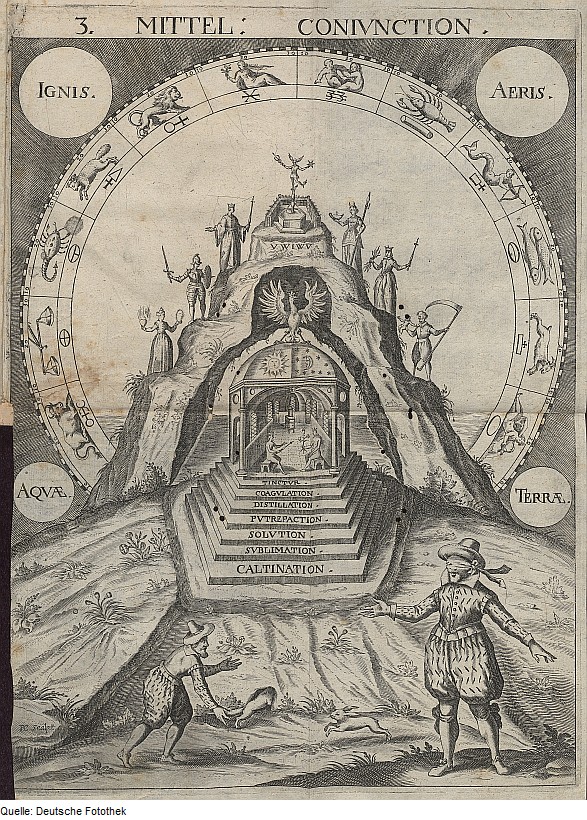
Stephan Michelspacher: »Cabala, Spiegel der Kunst und Natur: in Alchymia« (Cabala – Mirror of Art and Nature: In Alchemy), Chalcography, 1615. Probably one of the best-known allegories in the great work of alchemy. It depicts the basic concepts and steps in alchemy. The four elements, the zodiac and the seven planets, which also correspond to the (sometimes four, sometimes twelve or seven) seven stages of the alchemical process, which are depicted here as the stairs: Calcination, Sublimation, Solution, Putrefaction, Distillation, Coagulation, Tinctur. Overall, the whole alchemical operation is imitating nature (symbolized by the rabbit which the alchemist follows, but the savant ignores – thus, for the savant the entire inner world of the mountain where sun and moon meet will remain unknown to him) or just aiding nature to reach its final goal by shortening the time in which the process of developing to perfection takes place.
You can download complete alchemical libraries to your hard drive. Nevertheless, if you don’t handle them with the correct mindset, they will be of hardly any use! Moreover, the abundance of available information means, that we may never grasp completely different ways of transferring skills and knowledge, which may be even faster, deeper and more efficient than anything we can normally think of. In Taoist and Buddhist traditions, it is said, that there are masters who transfer all their knowledge to their best student shortly before their death. In the Cyber-Magic that Frater U. D. from Germany has developed in the 1980ies, there are similar approaches (but without the need to die for it).
One of my martial-arts-teachers, who is also a great master of magic, once gave me a light blow to the solar plexus at the end of a training session without comment. The next day I began to realize little by little, that my whole body and movement structure had completely changed overnight, and I could suddenly effortlessly and without thinking do all those things, my teacher was able to do.
I knew everything and was able to put into practice immediately what my teacher knew about movement, martial arts and magic, and he can do the hell of a lot of really, really amazing things, that you normally only know from Taoist legends! I was especially puzzled, that I was also able to transfer parts of this knowledge and these skills spontaneously to other people.
But insidiously, this phase was timed, so that it gradually subsided after a few weeks, and I returned to my familiar patterns of movement and thought. Nevertheless, this experience was an important stepping stone for developing these skills on my own, and it showed me, what possibilities exist for transferring knowledge, unheard of by most people.
So these points are the reason why I have made my peace with the fact, that my book has only been published once.
AH: Will there be an English edition any time soon? And which books would you recommend our English speaking readers if they were to get started?
DH: No, there is no English translation planned so far. Besides, I would have to make some alterations, as a lot of things have changed since the German edition.
To get started with the art of alchemy, I would always recommend to begin with plant spagyrics, as most teachers do. It is relatively easy to handle, but already familiarizes you with many basic techniques, without being really dangerous. Moreover, it is fun, you get quick results, and you can make many remedies, liquors and cosmetics for yourself, your family and friends. Most practitioners stick to exploring the plant kingdom, and that’s perfectly fine. A useful reading list of books in English language could be the following, preferably in that order:
Manfred Junius: The Practical Handbook of Plant Alchemy
Still a classic and simply a must-have.
Heliophilus: Alchemy Rising. The Green Book
Quite a recent publication with nice photos and good explanations of the processes given. These have also been selected with knowledge and care. I’m looking forward for the next books of this series to appear.
Combining both books give you a solid foundation of the principles of practical alchemy in general and plant spagyrics in particular, from where you can travel on. You find lots of experiments in them, some are easy and some rather tricky.
Daniel A. Schulke: Viradivum Vmbris. The Pleasure Garden of Shadows
Daniel A. Schulke: Ars Philtron. Concerning the Aqueous Cunning of the Potion and its Praxis in the Green Art Magical
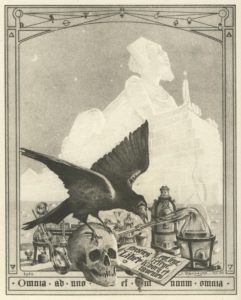
Coverpage of the book »Le Mystère des Cathédrales« by Fulcanelli (1926). Illustration by Jean Julien Champagne. Fulcanelli was an Alchemist of the early 20th century whose true identity is still unclear. Reportedly he achieved the stone. Among his students were Eugène Canseliet and Jean Juliene Champagne – both are sometimes considered candidates for Fulcanelli’s true identity. The language of birds or »langue verte« (green language) is a recurrent motive in alchemy. Who could understand the language of birds would be able to access perfect knowledge in wisdom. A motive we already find in Germanic mythology: in the Völsunga saga, Sigurd starts understanding the birds around him after accidentally tasting from the dragon blood. But the language of birds is sometimes also a synonym for music and indeed we find close ties between alchemy and music. The life of Manfred Junius may be a modern example, Michael Maier’s multimedia publication »Atalanta fugiens« may be another example (The 50 emblems with sound, example of sound including voice).
I love all the books by Xoanoan Press, particularly the works of Mr. Schulke. These two volumes are especially valuable for anyone working with plants on a more spiritual level, being a combination of magic and cunning lore with alchemical principles. Following the instructions can speed up your understanding of the mysteries of the vegetable kingdom and help you making alchemy a part of your daily life. Besides, they are written in a unique kind of language. Alchemy and language have always been inseparable. The Hermetic Art has never expressed itself in pure recipes. In addition to word-to-mouth-traditions, it has always been pictures, technical terms, symbols, parables, allegories and even architectural constructions that clothed its secrets. Many authors also used deliberate deception and misinformation. Mercury is after all also the god of liars and thieves, a “trickster”, as one would say in Shamanic traditions. The highest form of alchemical language is what Fulcanelli calls “The Language of Birds”, the unity between word, the mystery, its concealment and at the same time its revelation. Thus it becomes a sort of magic word, in which the written (or spoken) and the impact are one.
Some echoes of this can be found nowaday, for example, in what the master hypnotist Igor Ledochowski calls “mind-bending-language”, a special way of using language that bypasses the waking consciousness and thus addresses the unconscious directly, which is extremely efficient.
Stanislas Klossowski de Rola: The Golden Game. Alchemical Engravings of the 17th Century
A beautiful survey of baroque alchemical iconography. All the books, that the engravings have been taken from, can also be recommended for further studies, if you want to connect with the spiritual aspects of Western Hermeticism as well as with its laboratory side. Just let the images and their mysteries speak to you. Imagine how each and every one of these pictures may have affected a viewer at the time of their creation, in an epoch without TV, paintings on the wall, telephones, the Internet, clubs, streaming, concerts, online-shopping, wallpapers, associations, highways, advertisements, drive-ins, political parties, holidays, smartphones, post-offices, restaurants, pornography, electricity, theatres, drugs, bluetooth-speakers, posters, wellness-resorts, social networks, magazines, radio, cinema, selfies, shopping malls, and for most people even completely without books.
During this era, life was mostly lived in close rural communities, and hardly anyone traveled at all. The only highlights were the change of the weather, the cycle of the four seasons and their associated festivities, and the sequence of the celebrations of birth, marriage, offspring and (mostly) early death.
What impression would a person from such a living environment have had if he had suddenly found a book in which only ONE of these pictures had appeared? How would he have looked at this picture? How would it have stimulated his imagination? How would it have spoken to him? What would he have discovered in it?
Alexander von Bernus writes: “The researchers and scholars of today generally make the mistake of judging man of earlier centuries and completely earlier epochs in his organization and mental configuration according to ours of today, and to draw analogous conclusions from this. But this behaviour is quite absurd and leads to completely wrong ideas. (…) It is a complete misunderstanding of the entire development of mankind, if one believes, as is generally the case today, that the early Persian, the ancient Egyptian, even the archaic Greek or the Nordic people of the Edda would have experienced the same as the man of today. The state of mind at that time was so fundamentally different that the modern exegetes and researchers must inevitably come to a superficial and false interpretation of the great revelation-poems and writings of earlier epochs, if they approach them from the aspect of today’s mentality.“ (Alchymie und Heilkunst, Nürnberg 1972, p. 123).
I might add: In the meantime, we cannot even grasp the mental configuration of people of 20 or 30 years ago, not even our own, being now polluted by digital and other cognitive overload.
When I was about seven or eight years old for example, I was fascinated by the covers of some German horror novel paperbacks that were popular at that time (“Vampir-Horror-Taschenbuch” and “Dämonenkiller”). They had really gruesome pictures of decaying corpses and horrible monsters, and these images were very, very explicit for the 1970ies. I think, if some of them were printed on cigarette packets even today as a deterrent, it would drastically reduce the turnover of the tobacco industry.
To my disgust, my parents would not allow me to read these books, and my pocket money was not enough to buy them secretly. So I regularly walked long distances to train station bookstores and magazine stores to at least look at these covers and study their ghastly details to get a scary gooseflesh-kick from them, which then haunted me into my dreams. In the same way, I often went to the city to see the posters and stills of science fiction films or horror movies like the “Blind Dead”-flicks, Jean Rollin-, Dario Argento- and Lucio Fulci-movies or Godzilla-films for example, which I bitterly regretted to be too young to be permitted to watch. − All this may have been but a small personal glimpse of the effects that an overwhelming alchemical picture could have had on a person of olden days …
After letting the hermetic images in this book speak to you, you can read the interpretations given by de Rola, even if they shouldn’t make any sense to you. Confusion is a valuable component in alchemy, as it breaks our thought patterns, habits and biases. If used in a creative way, confusion can be a mighty tool for personal evolution. It is a materia prima par excellence, a chaos, the very seed of gold. Personally I don’t agree with some of de Rola’s explanations, but there is no absolute truth in this art, and this is also something one has to learn and to accept. Hermetic imagery is not a kind of crossword puzzle or treasure map with one and only correct answer to unleash. Intuition and intellectual understanding should always be united in a chymical marriage.
(Attributed to): Anton Josef Kirchweger:The Golden Chain of Homer
Another must-have. In hardly any other book is the alchemical view of nature better described than in this one. The practical work in it should be part of the basic knowledge of every serious spagyric, even if some of the higher processes only work up to a certain point, because there are some important omissions. I read this book at least once a year and always discover something new.
Lapidus: In Pursuit of Gold
A fine introduction into the Great Work, written by a pen friend of Aleister Crowley, but it has to be read with great care and a grain of salt. His suggested reading list is also very good.
Johann Seger von Weidenfeld: Concerning the Secrets of the Adepts
Alexander von Bernus, “The Paracelsus Research Society” and “The Philosophers of Nature” have greatly appreciated this book. The latter two, however, fell into the trap of claiming that the “Philosophical Spirit of Wine” is acetone and its derivatives. But this is definitely not the case! In this respect, the “Acetate Path” is an absolute aberration, no matter how often it is propagated. You can make good remedies this way, and you can also learn a lot about how to handle the substances you work with. But this has not much to do with High Alchemy.
Besides, this book gives you a perfect reading list for the rest of your life, if you are interested in the Great Work or the manufacture of REAL alchemical medicines, that surpass normal spagyrics by far. You won’t find a better survey of the books of trustworthy adepts to use as source works. All of the classical authors that Weidenfeld quotes, like (Pseudo-) Lullus, Basil Valentine, Paracelsus, George Ripley, Hollandus etc., are the real deal.
AH: If we come to reads, you encourage the reader to take on the classics himself and guide them into deciphering them on their own. You mention a large list of alchemical manuscripts from all centuries. If you would need to restrict yourself to a reading list of ten – which ones would make it on the list?
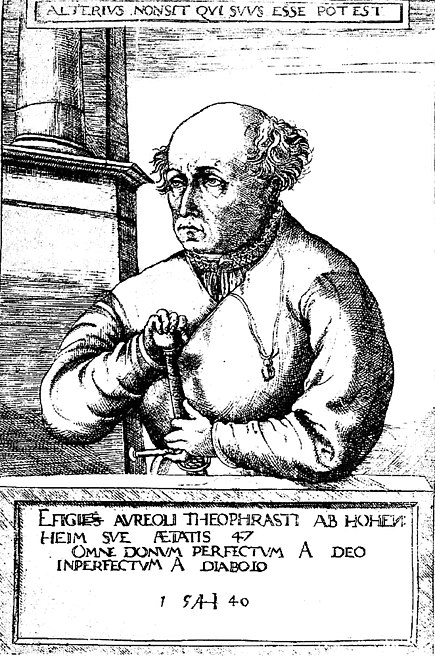
Paracelsus, or Theophrastus Bombast von Hohenheim. Chalcography, 1540. by Augustin Hirschvogel. Paracelsus was a Swiss physician and alchemist. Known and recognized for several advancements in medicine, including a stark criticism towards the back then prevalent humorism. Replacing them with the alchemical view of Mercury, Sulfur, and Sal Paracelsus developed new paradigms, for example he started to compare digestion to the alchemical process of fermentation, which also slowly gave way to a revolution in nutrition and cooking. The doctrine of signatures – crucial for hermetics and alchemy in many regards – advanced under him. We also find his descriptions of the elemental beings (gnomes, sylphs, undines and salamanders) until today in nearly all western occult traditions. Most modern alchemists still stay in his tradition.
DH: Here‘s my personal Top Ten. The book of Alexander von Bernus was for me personally the beginning of my journey and has influenced me a lot, that’s why it comes first. The rest of the order does not represent a ranking:
- Alexander von Bernus: „Alchymie und Heilkunst“. One of the best and most enlightening works ever!
- Johann Seger von Weidenfeld: „Concerning the Secrets of the Adepts“.
- Fulcanelli: „Mystery of the Cathedrals“ and „Dwellings of the adepts“. I consider both books as one, that is why I also count them as one here.
- Pierre Jean Fabre: Collected works. Unjustly a rather unknown author, he left behind a monumental, very original oeuvre, covering all areas of spagyrics and alchemy, their symbolism, theory and practice.
- Christoph von Paris: „Elucidarius“.
- Anonymous: „Schlüssel der wahren Weisheit“. You can learn a lot from the last two!
- Conrad Khunrath: „Medulla destillatoria“. One of the most interesting books, if you are looking for suggestions for spagyric remedies.
- Paracelsus: Collected works.
- Johann und Johann Isaac Hollandus: Collected works.
- Basilius Valentinus: Collected works. No serious student of this art can avoid these last three!
AH: One curiosity if permitted: during the entire book you do not mention Dom Pernety at all, even though he is often considered an essential read. Is there a special reason for this?
DH: Quite simply, at the time of writing, I had Perny’s works in my collection, but I had not yet read them. But his “Treatise on the Great Art” is very good, and also his “Dictionnaire Mytho-Hermétique” is full of valuable references.
AH: What is your take on Isaac Newton’s alchemical writings?
DH: He shows us that “animated mercury”, may appear to have some unusual physical properties, but that the Great Work cannot be executed in this way. Unfortunately, after almost 500 years, there are still people who believe that they can reach their goal by this route.
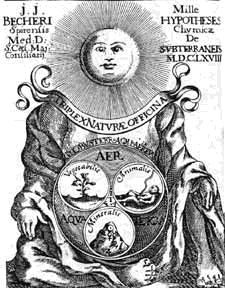
The three kingdoms of nature as seen in Alchemy: The animalic kingdom of both man and animals, the kingdom of plants and the kingdom of minerals. Each kingdom has its own degree of difficulty and procedures – even its own stone. Image: Actorum Laboratoriichici Monacensis, seu Subterraneae, Johann Joachim Nercher, Frankfurt, 1669. The image depicts the realized alchemist, who, has mastered the four elements and three kingdoms and thus, rules in an enlighted state as the sun above them all.
AH: Alchemy distinguishes between the mineral realm, the realm of plants, animals and the realm of men. The difficulty of alchemical operations increases as we move towards the mineral realm because one objective is to make the substance better adapted to the human body. However, you ordered the difficulties as follows: plants, animal kingdom including human substances, inorganic substances. Why this switch between the realm of animals and plants?
DH: This is primarily due to the differences in putrefaction. With plants it is quite easy to carry out a fermentation process. In animals, however, too much putrefaction can ruin the whole work. The result is then not necessarily easier for the organism to assimilate at all.
AH: For the first alchemical steps you invite the reader to experiment with plant tinctures – solutions based on one ingredient – and elixirs – solutions based on a mixture of ingredients. But you do not give here any particular suggestions or recipes. For the other realms in the book – the operas of the animal and mineral kingdom – suggestions seem more specific as for the outcome. What is the rationale here? Is it maybe even completely arbitrary what tinctures and elixirs are made for a starter?
DH: Exactly. With single essences, you can start with any plant, with which you may have a special relationship, or with those that are readily available, or you can choose those, that are suitable for a particular disease you wish to cure. It doesn’t matter, what you start with, as long as you do it!
As for compound elixirs from plants, there are so many recipes that it is impossible to pick out anything special. It is also necessary to distinguish between compound elixirs, which are supposed to have a general toning effect on the body, and others, which serve against specific complaints. The intensive study of herbal books to find an elixir, that appeals to you, can thus help to promote your own intuition, as well as developing confidence in approaching the world of plants. This is always better than serving everything pre-digested. With animal products, minerals and metals, the possibilities for error are much greater, so the didactics should be different in these realms.
AH: And how would you recommend to get more proficient in the plant kingdom? Are books in herbalism of any use from an alchemical point of view?
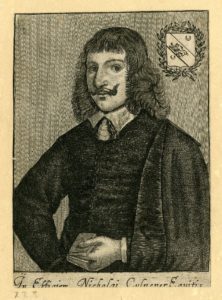
Nicholas Culpeper was a physician, herbalist, and astrologer in 17th century England. His book the »Complete Herbal« is still printed today. Culpeper related diseases and plants to astrology and advocated empirical knowledge rather than just following older authors. This strong inclination to own experience and first-hand knowledge is something already Agrippa von Nettesheym distinguished from his contemporaries. Painting/Portrait by Richard Gaywood, etching between 1644 and 1662
DH: Whether historical or modern: Books on herbal medicine should not be missing in any alchemical collection. They are indispensable for obtaining a profound knowledge of the nature and effects of herbs. Besides, many of the older authors like Leonhardt Thurneysser zum Thurn, Theodorus Tabernaemontanus, Nicolas Culpeper, Johann Joachim Becher, Frank von Frankenau, Samuel Müller, Bartholomaeus Carrichter, Johann Jacob Bräuner, Walther Ryff, Johannes Hiskias Cardilucius, Christoph Hellwig etc. have also practiced spagyrics and alchemy.
Apart from pure reading, you can practise recognising the plants you encounter on walks and try to let their nature take effect on you, instead of stepping blindly past them. Gardening, fermenting food, regularly preparing teas, wild herb salads, herbal baths, fumigations, brewing wine or beer from fruits and herbs, making herb liqueurs etc. is also a good way to get in touch with the vegetable world.
Spagyric is first of all a set of pure techniques, but knowledge of the plants and their nature is the prerequisite for using these techniques successfully. Otherwise you act like a mere technocrate. This is best achieved, the more familiar you are in everyday life with those plants, that grow all around you.
AH: After some proficiency in the plant kingdom is achieved, the student can prepare the »Plant-Stone«. What is this about and what are the next steps on the way to becoming a master alchemist?
A plant-stone, which can be produced in both solid and liquid form, is the essence of the highest and purest potentials of a plant that have been released. In contrast to other preparations, it works not only on the material plane but also on various subtle levels. It can be used as a very potent medicine, for rejuvenation and as a tool for personal development. Once you have become adept at making plant-stones, you can begin to devote yourself more intensively to the other natural kingdoms, especially minerals and metals. Alchemy should slowly become an integral and indelible part of daily life. Techniques of inner alchemy can be very helpful in this process. Under no circumstances should one be too ashamed to make mistakes. Failures will always accompany us on our path anyway. And as banal as it may sound: the road to mastery consists of one thing: practice, practice, practice!
AH: You also run your own shop over the internet and a small publishing house. The website is named fulcanelli.de and indeed you mention Fulcanelli quite often in your book. What is his significance for the practitioner today?
DH: Fulcanelli’s books are definitely one of a kind. They teach us to really read and to discover the Mysteries where we might not even suspect them. Although they are not how-to-books, they are full of practical hints, and the processes he describes should be reworked at some point if possible. Sometimes it is claimed that these texts are only suitable for advanced hermetics. I do not see it that way. Even beginners should read them, if only to immerse themselves in their linguistic atmosphere and their secrets, and let them confuse them. – Here too, what I have already said about confusion applies! For a long time I thought that these linguistic bolides were absolutely untranslatable. But Dr. M. P. Steiner has taught me a better lesson. With his German translations, for which he needed decades, he has done an absolutely fantastic job. It could not have been done better!
AH: In the Edition Hornfisher also appeared a book about Jiaogulan – a Chinese herb which is praised as the plant of youth or described as “ginseng, only better”. Today we have access to several herbs which are not native to our surroundings. Ginseng, Echinacea, but also witchhazel (at least for the Europeans among us) are just some examples. Is it from an alchemical point of view important whether a herb is local to the practitioner or not?
DH: It is absolutely useful to first deal with one’s own immediate environment in order to learn its secrets and those of its plants. Paracelsus’ dictum, “that where the disease appears, its remedy also grows”, cannot be denied. But the world does not end at our garden fences, and even in very old pharmacopoeias exotic ingredients were often considered to be particularly potent. For a long time Guaiac was considered a miracle weapon against syphilis, and when drugs such as coffee, tea and cocoa became popular in the 17th century, many books were published about their healing effects, sometimes bringing them close to Panaceas. So: Don’t limit yourself in any way!
AH: You are currently working on a book about “high alchemy” – when can we expect it to appear and can you already tell something about the content?
DH: Unfortunately, the appearance will be delayed for quite a while. Numerous other projects still take up too much of my time, and the linguistic presentation of the text also burdens me with unexpected challenges. In terms of content, the book will deal exclusively with the Great Work, whereby I will explain, among other things, many processes that Alexander von Bernus only vaguely hinted at in his writings.
AH: What other plans do you have for the future?
DH: There are numerous book projects of old texts from different subject areas (not necessarily alchemical), which I want to publish. Among them are some completely, but unjustly forgotten naturopathic procedures, that are extremely powerful. Another book I’m working on is about medically effective beers.
And otherwise: My plan is “Refining the elixir”, to put it in Taoist terms. This is a project that never ends and that pervades everything.
AH: So you maintain a large variety of interests… As for the hermetic arts, you also practice magic and especially, Enochian magick. Rather than diving into the next subject I’d just like to ask: how much time do you devote to your occult work?
DH: I practice daily and also try to maintain some techniques permanently, even during sleep.
AH: Another question I have to ask – because I ask it everyone interviewed here – what is your take on Aleister Crowley?
DH: He has had a big influence on me from my teenage days ‘till my early twenties. I still appreciate him as a pioneer in many fields and as a unique personality and eccentric. Many of his essays and other writings are still top-notch today, because of Crowley’s razor-sharp intelligence, his nonconformism, his great spiritual experience and his humor. He was also perhaps the first to make a large set of powerful occult techniques generally available to the public. In addition, he was one of the few advocates of the concept of self-initiation in his days, despite his elitarism and his faible for founding lodges.
However, in my opinion, with his concept of Thelema and proclaiming himself as the Logos and saviour of the New Aeon, he fell into the trap of many gurus and religion founders, who indulge in fantasies of world-salvation and megalomania.The manic obsession, with which Crowley subordinated everything to the Law of Thelema in his later life and works, robbed him of much of his original fire. This and all that his successors have made of it, has little to do with liberation, but much to do with dogmatism, narrow-mindedness and clubs and societies. Finally, I agree with Frater U. D.’s assessment that Crowley was not so much a magician, but rather a mystic. There’s nothing wrong with that of course, but labeling him a magician in the first place, as it is mostly done, is somewhat debatable.
AH: Mr. Hornfisher, thank you!


Nosch | June 1, 2020
|
Nice, Daniel … very interesting and great, someone like you preserves the old wisdom of mankind and nature! ☺❤??
Mário Manuel Coelho | June 15, 2020
|
beautifully written interview many thanks for the sharing of such wisdom that health is upon I and I dear I both et all for long years on Namaskar.
Jim | October 15, 2020
|
Wow. Thank you so much for this interview. I am glad to be your student, dear Mr. Hornfisher.
God bless you.
Caleb | February 15, 2022
|
I’m curious as it keeps presenting itself in my study. What is the difference between a mystic and a magician?